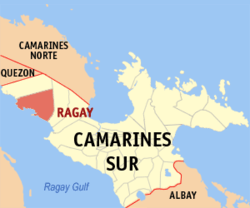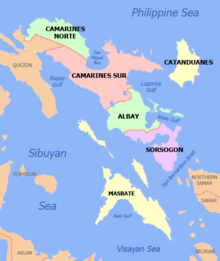Ragay, Camarines Sur
Ragay, officially the Municipality of Ragay (Central Bicolano: Banwaan kan Ragay; Tagalog: Bayan ng Ragay), is a 1st class municipality in the province of Camarines Sur, Philippines. According to the 2015 census, it has a population of 58,214 people.[3]
Ragay | |
|---|---|
| Municipality of Ragay | |
 Seal | |
 Map of Camarines Sur with Ragay highlighted | |
OpenStreetMap 
| |
.svg.png) Ragay Location within the Philippines | |
| Coordinates: 13°49′06″N 122°47′32″E | |
| Country | |
| Region | Bicol Region (Region V) |
| Province | Camarines Sur |
| District | 1st district |
| Barangays | 38 (see Barangays) |
| Government | |
| • Type | Sangguniang Bayan |
| • Mayor | Thaddeus A. Ramos |
| • Vice Mayor | Elmer A. Linao |
| • Congressman | Marissa Lourdes M. Andaya |
| • Electorate | 37,404 voters (2019) |
| Area | |
| • Total | 400.22 km2 (154.53 sq mi) |
| Population (2015 census)[3] | |
| • Total | 58,214 |
| • Density | 150/km2 (380/sq mi) |
| • Households | 12,453 |
| Economy | |
| • Income class | 1st municipal income class |
| • Poverty incidence | 44.65% (2015)[4] |
| • Revenue (₱) | 152,585,345.48 (2016) |
| Time zone | UTC+8 (PST) |
| ZIP code | 4410 |
| PSGC | |
| IDD : area code | +63 (0)54 |
| Climate type | tropical rainforest climate |
| Native languages | Central Bikol Manide Tagalog |
| Website | ragay |
History
No date was known as to the establishment of the municipality of Ragay although it was recorded that the town was still a visita of Lupi on April 15, 1753.
Barangays
Ragay is politically subdivided into 38 barangay's.
- Agao-ao
- Agrupacion
- Amomokpok
- Apad
- Apale
- Banga Caves
- Baya
- Binahan Proper
- Binahan Upper
- Buenasuerte
- Cabadisan
- Cabinitan
- Cabugao
- Caditaan
- Cale
- Godofredo Reyes Sr.(Catabangan Crossing)
- Catabangan Proper
- Inandawa
- Laguio
- Lanipga-Cawayan
- Liboro
- Lohong
- Lower Omon
- Lower Santa Cruz
- Panaytayan
- Panaytayan Nuevo
- Patalunan
- Poblacion Ilaod
- Poblacion Iraya
- Port Junction Norte
- Port Junction Sur
- Salvacion
- Samay
- San Rafael
- F. Simeon (Pugod)
- Tagbac
- Upper Omon
- Upper Santa Cruz
Demographics
| Year | Pop. | ±% p.a. |
|---|---|---|
| 1918 | 3,811 | — |
| 1939 | 11,514 | +5.41% |
| 1948 | 20,062 | +6.36% |
| 1960 | 27,925 | +2.79% |
| 1970 | 32,635 | +1.57% |
| 1975 | 32,798 | +0.10% |
| 1980 | 34,891 | +1.24% |
| 1990 | 41,438 | +1.73% |
| 1995 | 44,154 | +1.20% |
| 2000 | 47,743 | +1.69% |
| 2007 | 52,021 | +1.19% |
| 2015 | 58,214 | +1.42% |
| Source: Philippine Statistics Authority[3][5][6][7] | ||
In the 2015 census, the population of Ragay, Camarines Sur, was 58,214 people,[3] with a density of 150 inhabitants per square kilometre or 390 inhabitants per square mile.
Climate
| Climate data for Ragay, Camarines Sur | |||||||||||||
|---|---|---|---|---|---|---|---|---|---|---|---|---|---|
| Month | Jan | Feb | Mar | Apr | May | Jun | Jul | Aug | Sep | Oct | Nov | Dec | Year |
| Average high °C (°F) | 32 (90) |
31 (88) |
35 (95) |
37 (99) |
37 (99) |
36 (97) |
36 (97) |
34 (93) |
35 (95) |
34 (93) |
33 (91) |
32 (90) |
34 (94) |
| Average low °C (°F) | 27 (81) |
27 (81) |
28 (82) |
30 (86) |
31 (88) |
31 (88) |
30 (86) |
29 (84) |
29 (84) |
29 (84) |
28 (82) |
28 (82) |
29 (84) |
| Average precipitation mm (inches) | 159.85 (6.29) |
61.25 (2.41) |
60.56 (2.38) |
43.28 (1.70) |
69.32 (2.73) |
183.65 (7.23) |
346.37 (13.64) |
386.41 (15.21) |
281.42 (11.08) |
296.39 (11.67) |
389.18 (15.32) |
119.9 (4.72) |
2,397.58 (94.38) |
| Average rainy days | 26 | 22 | 22 | 18 | 20 | 26 | 30 | 31 | 28 | 28 | 30 | 28 | 309 |
| Source: World Weather Online[8] | |||||||||||||
gollark: Someone pinged me.
gollark: Anyway. Find them in JEI and rightclick on those or hit U while hovering over them. Something like that.
gollark: I'm still logged in?!
gollark: Give me your SSH keys plz.
gollark: If we need anything we need monad tutorials.
References
- "Municipality". Quezon City, Philippines: Department of the Interior and Local Government. Retrieved 31 May 2013.
- "Province: Camarines Sur". PSGC Interactive. Quezon City, Philippines: Philippine Statistics Authority. Retrieved 12 November 2016.
- Census of Population (2015). "Region V (Bicol Region)". Total Population by Province, City, Municipality and Barangay. PSA. Retrieved 20 June 2016.
- "PSA releases the 2015 Municipal and City Level Poverty Estimates". Quezon City, Philippines. Retrieved 1 January 2020.
- Census of Population and Housing (2010). "Region V (Bicol Region)". Total Population by Province, City, Municipality and Barangay. NSO. Retrieved 29 June 2016.
- Censuses of Population (1903–2007). "Region V (Bicol Region)". Table 1. Population Enumerated in Various Censuses by Province/Highly Urbanized City: 1903 to 2007. NSO.
- "Province of Camarines Sur". Municipality Population Data. Local Water Utilities Administration Research Division. Retrieved 17 December 2016.
- "Ragay, Camarines Sur: Average Temperatures and Rainfall". World Weather Online. Retrieved 29 October 2017.
External links
This article is issued from Wikipedia. The text is licensed under Creative Commons - Attribution - Sharealike. Additional terms may apply for the media files.
